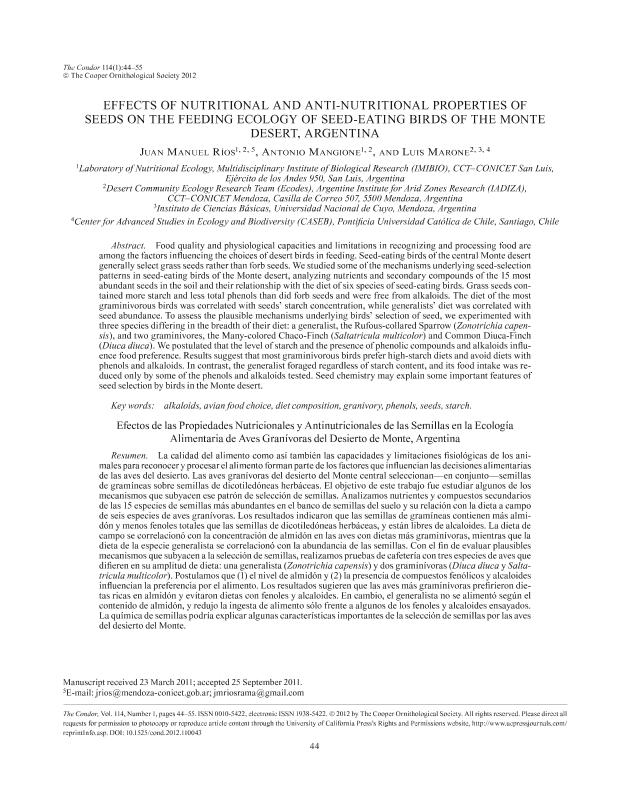Mostrar el registro sencillo del ítem
dc.contributor.author
Rios, Juan Manuel

dc.contributor.author
Mangione, Antonio Marcelo

dc.contributor.author
Marone, Luis

dc.date.available
2018-06-15T18:38:40Z
dc.date.issued
2012-02
dc.identifier.citation
Rios, Juan Manuel; Mangione, Antonio Marcelo; Marone, Luis; Effects of nutritional and anti-nutritional properties of seeds on the feeding ecology of seed-eating birds of the Monte desert, Argentina; Cooper Ornithological Society; The Condor; 114; 1; 2-2012; 44-55
dc.identifier.issn
0010-5422
dc.identifier.uri
http://hdl.handle.net/11336/48842
dc.description.abstract
Food quality and physiological capacities and limitations in recognizing and processing food are among the factors influencing the choices of desert birds in feeding. Seed-eating birds of the central Monte desert generally select grass seeds rather than forb seeds. We studied some of the mechanisms underlying seed-selection patterns in seed-eating birds of the Monte desert, analyzing nutrients and secondary compounds of the 15 most abundant seeds in the soil and their relationship with the diet of six species of seed-eating birds. Grass seeds contained more starch and less total phenols than did forb seeds and were free from alkaloids. The diet of the most graminivorous birds was correlated with seeds' starch concentration, while generalists' diet was correlated with seed abundance. To assess the plausible mechanisms underlying birds' selection of seed, we experimented with three species differing in the breadth of their diet: a generalist, the Rufous-collared Sparrow (Zonotrichia capensis), and two graminivores, the Many-colored Chaco-Finch (Saltatricula multicolor) and Common Diuca-Finch (Diuca diuca). We postulated that the level of starch and the presence of phenolic compounds and alkaloids influence food preference. Results suggest that most graminivorous birds prefer high-starch diets and avoid diets with phenols and alkaloids. In contrast, the generalist foraged regardless of starch content, and its food intake was reduced only by some of the phenols and alkaloids tested. Seed chemistry may explain some important features of seed selection by birds in the Monte desert. © The Cooper Ornithological Society 2012.
dc.format
application/pdf
dc.language.iso
eng
dc.publisher
Cooper Ornithological Society

dc.rights
info:eu-repo/semantics/openAccess
dc.rights.uri
https://creativecommons.org/licenses/by-nc-sa/2.5/ar/
dc.subject
Alkaloids
dc.subject
Avian Food Choice
dc.subject
Diet Composition
dc.subject
Granivory
dc.subject
Phenols
dc.subject
Seeds
dc.subject
Starch
dc.subject.classification
Otras Ciencias Biológicas

dc.subject.classification
Ciencias Biológicas

dc.subject.classification
CIENCIAS NATURALES Y EXACTAS

dc.subject.classification
Meteorología y Ciencias Atmosféricas

dc.subject.classification
Ciencias de la Tierra y relacionadas con el Medio Ambiente

dc.subject.classification
CIENCIAS NATURALES Y EXACTAS

dc.title
Effects of nutritional and anti-nutritional properties of seeds on the feeding ecology of seed-eating birds of the Monte desert, Argentina
dc.type
info:eu-repo/semantics/article
dc.type
info:ar-repo/semantics/artículo
dc.type
info:eu-repo/semantics/publishedVersion
dc.date.updated
2018-04-24T16:46:20Z
dc.journal.volume
114
dc.journal.number
1
dc.journal.pagination
44-55
dc.journal.pais
Estados Unidos

dc.journal.ciudad
California
dc.description.fil
Fil: Rios, Juan Manuel. Consejo Nacional de Investigaciones Científicas y Técnicas. Centro Científico Tecnológico Conicet - Mendoza. Instituto Argentino de Investigaciones de las Zonas Áridas. Provincia de Mendoza. Instituto Argentino de Investigaciones de las Zonas Áridas. Universidad Nacional de Cuyo. Instituto Argentino de Investigaciones de las Zonas Áridas; Argentina. Pontificia Universidad Católica de Chile; Chile. Consejo Nacional de Investigaciones Científicas y Técnicas. Centro Científico Tecnológico Conicet - Mendoza. Instituto Argentino de Nivología, Glaciología y Ciencias Ambientales. Provincia de Mendoza. Instituto Argentino de Nivología, Glaciología y Ciencias Ambientales. Universidad Nacional de Cuyo. Instituto Argentino de Nivología, Glaciología y Ciencias Ambientales; Argentina
dc.description.fil
Fil: Mangione, Antonio Marcelo. Consejo Nacional de Investigaciones Científicas y Técnicas. Centro Científico Tecnológico Conicet - San Luis. Instituto Multidisciplinario de Investigaciones Biológicas de San Luis. Universidad Nacional de San Luis. Facultad de Ciencias Físico Matemáticas y Naturales. Instituto Multidisciplinario de Investigaciones Biológicas de San Luis; Argentina. Consejo Nacional de Investigaciones Científicas y Técnicas. Centro Científico Tecnológico Conicet - Mendoza. Instituto Argentino de Investigaciones de las Zonas Áridas. Provincia de Mendoza. Instituto Argentino de Investigaciones de las Zonas Áridas. Universidad Nacional de Cuyo. Instituto Argentino de Investigaciones de las Zonas Áridas; Argentina
dc.description.fil
Fil: Marone, Luis. Pontificia Universidad Católica de Chile; Chile. Consejo Nacional de Investigaciones Científicas y Técnicas. Centro Científico Tecnológico Conicet - Mendoza; Argentina. Universidad Nacional de Cuyo. Facultad de Ciencias Exactas y Naturales; Argentina
dc.journal.title
The Condor

dc.relation.alternativeid
info:eu-repo/semantics/altIdentifier/doi/http://dx.doi.org/10.1525/cond.2012.110043
dc.relation.alternativeid
info:eu-repo/semantics/altIdentifier/url/http://www.bioone.org/doi/abs/10.1525/cond.2012.110043
Archivos asociados
